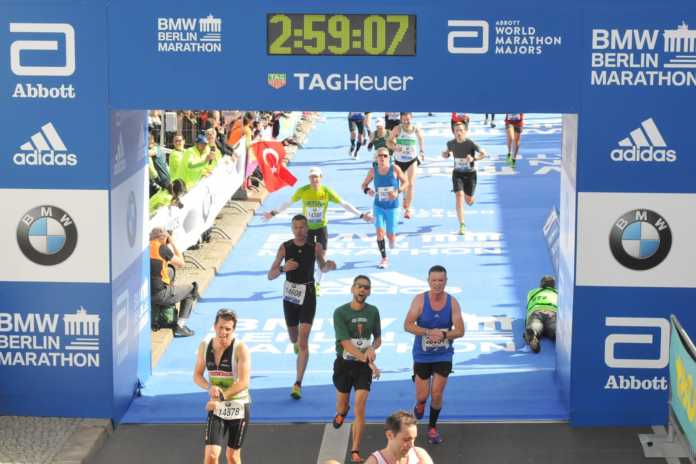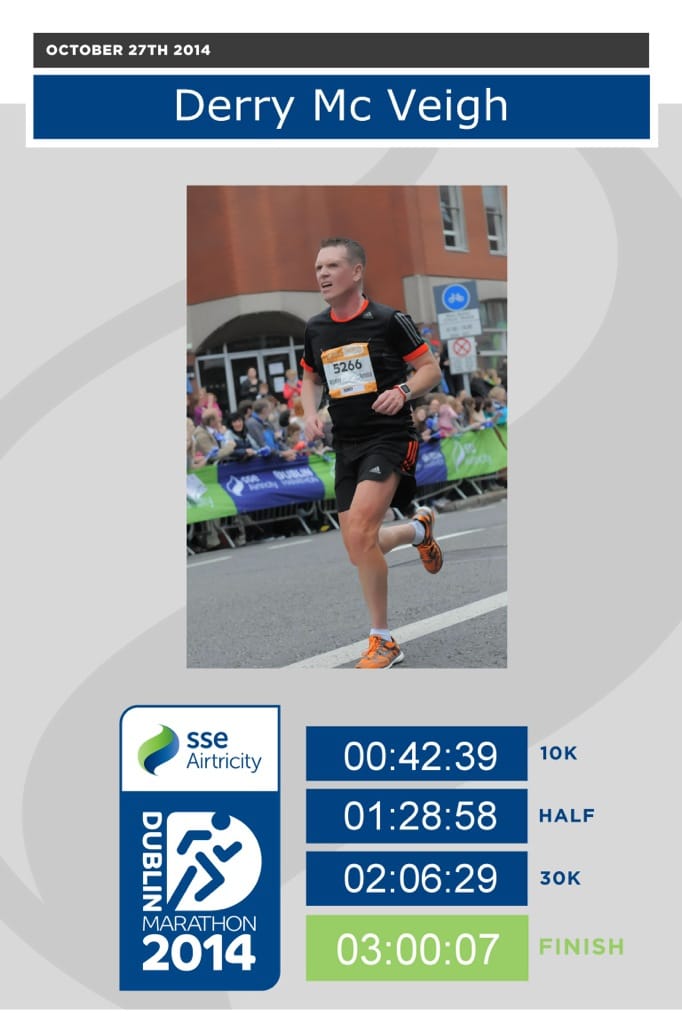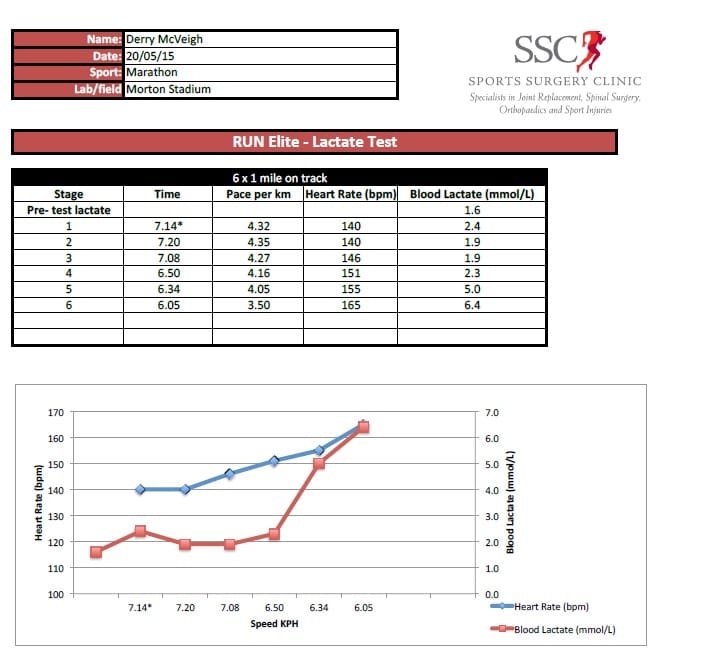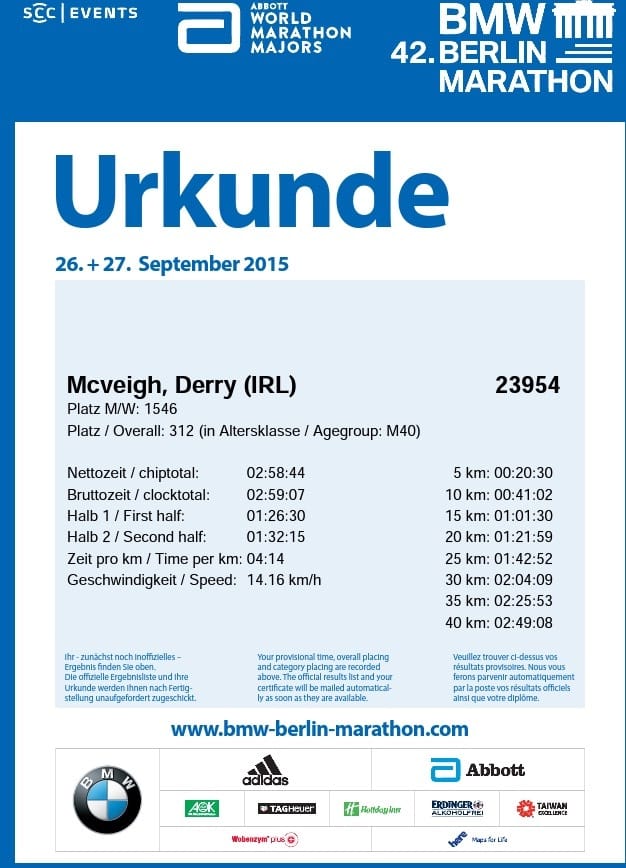Thursday, November 26, 2015
Thursday, November 19, 2015
Mind over Matter. The Sub 3 hour Marathon.

Original article available here.
Irish International Ultra Runner John O’Regan explains how he helped train Derry McVeigh, A Lust for Life team member and sports agent, on how to break the 3 hour marathon mark. “It doesn’t need to be the loneliness of the long distance runner”.
Background
I got to know Derry through our local parkrun back in January 2014. It was Saturday 18th January and he finished 2 seconds ahead of me after putting in a sprint finish that I couldn’t match. We met again on Saturday 25th January and this time I finished 8 seconds behind with Derry showing signs of improvement and then on Saturday 01st March we ran together in a small group with Derry again finishing ahead of me. This time he was first over the line.

We got talking and he told me of his plan to run a sub 3hr Marathon in Dublin later that same year. Thinking to myself that 3hrs should be a handy enough target for him based on his 5K times I didn’t say too much and we continued to battle it out whenever we met at parkrun.
Soon after the Dublin Marathon, we met again at parkrun and I was very surprised to hear that he had missed his target by 7 seconds and had experienced a very tough day. This was even more surprising when he told me that he had finished a parkrun in 17:17 less than a week after the Dublin Marathon.
Defining Moment
Jump forward to 2015 and we met up for a long run in March with Derry’s two training partners (Karl and Stephen). I was the guest so I sat at the back and felt under pressure soon after starting which had me thinking that maybe I wasn’t fit enough to run with these guys. Halfway through the run we stopped at a quiet junction to retrieve a bag containing energy drinks and gels and it was then I realised that the lads were just running and weren’t doing a specific session. They were going too fast on their long run and it was becoming just another run which wasn’t helping to prepare for the Marathon and this could be the reason for Derry missing his target in Dublin.
The Beginning
I said nothing until after the run and then took the gamble of telling Derry that I knew why he hadn’t achieved his sub 3hr Marathon. We had a brief chat and I gave him an idea of what I thought he would need to do which would make running a lot easier than it had been and I made a few suggestions to help make the most use of his available time. Quite simply it was a case of ‘You can do the same thing and get the same result or you can try something different.’ He was interested!
Derry got back in touch and said he’d been thinking about what we’d been talking about and it made sense. He asked if I’d help with a training plan and this was time for me to walk the talk. I didn’t have time to train regularly with Derry so I needed a way to control what he was doing by checking what he had done. We had less than 4 months until the next Sub 3 attempt in Berlin.
To start things off I suggested he buy a Heart Rate Monitor and we decided on the Garmin 225 as the software included (Garmin Connect) would allow me to view the sessions he had completed and I could then monitor his progress and suggest changes if required. To get the most from a Heart Rate Monitor it helps to know your lactate threshold which is the fastest pace you can run without generating more lactic acid than your body can process.

Knowing the heart rate at which this happens will allow you to stay below it and could be compared with the difference between keeping a pot of water simmering rather than letting it boil. You can make an educated guess based on feel and comparing with race results and hard sessions but it’s still only a guess and won’t help to maximise your performance. We did a few guessed sessions during which I was cautious not to overdo it as I felt that Derry was always training harder than he needed to be so my main objective was to slow him down and get him used to doing easier runs. The added advantage of using the Garmin made it easier to monitor progress from a distance as I could easily see from uploaded files if there was an increase or decrease in distance covered as the weeks progressed.
The Plan
It was May 20th and Derry made an appointment to do a Lactate Test with Colin Griffin at the Sports Surgery Clinic in Santry. This test consisted of 6* 1 mile controlled intervals on the track under the observation of Colin with a small blood sample taken at the end of every mile to measure lactate levels and heart rate was recorded. The results were no less than I expected and confirmed what I had been thinking. I used the information received from the test to structure a few definite sessions to ensure that Derry was running easy enough on easy days and hard enough on the harder days. A common mistake is running easy sessions too hard which means you might not be sufficiently rested and recovered to run the harder runs as they should be run with the end result being that all runs are more or less the same.

We sat down and designed an individualised adaptable training plan that would make the most use of his available time with regular checks along the way to ensure the plan was productive. We looked for windows of opportunity in the working week and also used times that were already working for training runs. A typical week included a Lactate Threshold Interval Session, a tempo run, a long run and the rest was easy running. The long run was one of the big changes and we shifted the format of this run from pace to an aerobic heart rate zone with it being measured in time rather than distance.
The Training
The best plan isn’t always the best plan and to make something work you need to fit it around your life, rather than fit your life around what you are trying to do. Getting this right will immediately remove a stress or at least make the training less stressful and make it more workable. Training with friends makes it a lot easier and the early morning or late nights become more bearable. Involving others can make all the difference and if those others are like minded with similar goals and objectives then your chances of success will improve from the beginning.
Derry was lucky as he had a group of regular motivated training partners which was a great start and this didn’t just happen by chance as they came together by design and in a similar way that I got involved. We share a common interest and got chatting after one of our many battles during a parkrun. Finishing close enough together shows the similar ability and we all realised that training is easier with company if we embrace it.
A perfect example of fitting the training around your life would be the Lactate Threshold session as we designed a session of just the right duration to be completed during a running commute to work. Early morning was also perfect for this run because it required energy and concentration and was the perfect start to a busy day.
Making it work
From my observation they had evolved into a same pace and every run was more or less the same. We needed to change the training but not change the training partners and keep them involved as they were crucial to the success of the plan. On a few occasions when we talked, Derry told me that if he hadn’t committed to meeting the other guys for an early morning run at the weekend then he would have stayed in bed.
Goals and objectives can differ but with some thought out scheduling it was possible to still do individualised training sessions while running in a group. As an example, Derry was able to do an easy session while running with someone of lesser fitness doing a faster session. Some sessions can’t be compromised as specific work needs to be done but if you look around you will find that there’s always someone looking for company and would love to tag along.
It won’t always work out as when you are training in a group you need to compromise and find a middle ground that suits all but luckily for Derry, Karl and Stephen were close to the same fitness level and equally benefited from the session. I think that the key to this training cycle being a success was due to the network of friends and training partners that Derry had around him and it was important to keep them involved.
During a big city marathon you have all the distractions along the way with the mile markers very obvious and breaking the distance into manageable chunks but when you are alone it takes a lot more mental effort to stay focussed and motivated. Training alone is still beneficial and some people prefer it but if you find that your motivation is starting to wear off then you should consider finding a training partner for the occasional run.
Monitoring Progress
Along the way it was necessary to monitor progress to ensure that the training was productive or in some cases to discover in time if it was unproductive and needed changing. With that in mind we decided to use the regular interval session as used during the commute. This particular session became the benchmark and the improvements were obvious. As Derry got fitter from the training he had to work harder which in turn means run faster to elevate his heart rate into the training zone and this meant covering more distance in same time.
Derry had registered for the Rock and Roll Half Marathon in Dublin on 2nd August and we discussed using this as a performance indicator with the finishing result being very positive and confirming we were on track.
A perfect example of how this plan was workable would be an observation of the Interval Session that was fitting in around a commute into work which consisted of 3*15 mins at Lactate Threshold with 5 mins recovery between reps. This started with a warm up that lasted as long as it needed to last and finished with a cool down. As the weeks progressed this session was resulting in more distance being covered during the 15 minute sections for the same heart rate. This meant the training was done before the working day had begun and it was utilising the time that would have been spent commuting. The long run was done on a Sunday and as it got longer it started earlier.
Tapering and Race Week
Race week came around very quickly which highlighted the importance of making the best use of available time as it seemed like we arrived at the start line just at the right moment. The tapering period was short but definite with a reduction in training volume while maintaining some intensity. Most importantly the temptation to sign up for shorter races or racing in training was resisted. Racing in training is simply running faster than you should be running and testing your fitness when you should be saving it.
Derry travelled to Berlin and was confident enough with his training to prevent any panic at the start. We had talked through the race and worked on a strategy based on previous experience. We knew where the sticking points would be and because of that we had gone beyond them in training and proved in advance that it could be done. We talked about when it would hurt and how much it would hurt and although slowing down or stopping might temporarily ease that pain it was nothing like the pain of knowing you’d given up and missed your target by just a few seconds as was the case in Dublin 2014.
It was a fast start but he got back onto pace and played a patient game knowing that he had prepared well and the recent performance indicators had all indicated he should achieve his target. Marathons can be strange events in that you are amongst a group of 10-40,000 but after a certain point you can feel all alone in your own little world of pain and for Derry this was to happen at 35K.
 For a moment he was disorientated and forgot where he was but then he remembered that he was here before and knew he had the experience to deal with it. Rather than slowing down he put in an extra effort which wasn’t to speed up but to just maintain the pace as tired legs require more energy for the same output. At 37K he told me that he had thoughts of giving up and pulling out of the race but those thoughts were cancelled out by more positive affirmations remembered from Karl and Stephen as they talked each other through long run after long run.
For a moment he was disorientated and forgot where he was but then he remembered that he was here before and knew he had the experience to deal with it. Rather than slowing down he put in an extra effort which wasn’t to speed up but to just maintain the pace as tired legs require more energy for the same output. At 37K he told me that he had thoughts of giving up and pulling out of the race but those thoughts were cancelled out by more positive affirmations remembered from Karl and Stephen as they talked each other through long run after long run.
He remembered all the early nights just so he could have an early morning and some days arriving into work feeling like he’d already done a day’s work and that he hadn’t done all of that to drop out at 37K. Most of all he remembered the feeling of just missing out on a Sub 3 finish with his last attempt by only 10 seconds and he didn’t want to feel that way again.
He then did what he did on those unpressured training runs away from witness and just kept going and although the self doubt was still there he didn’t give up as he knew that this wasn’t just for him as others where depending on the result including me. It was only when someone passed him at 40K and told him that if he kept going at the pace he was at then he would finish in under 3hrs. This positive cue was all that was needed to switch back on again and the pace which he described as comfortably painful was maintained all the way to the finish and he crossed the line with a smile and a new personal best of 2:58.44 and the elusive sub 3hr Marathon.
You never really know what will happen on the day but if you prepare well then you give yourself the best possible start.
Monday, November 2, 2015
Looking beyond the Finish Line
Over the past 15 years I’ve competed in some of the most extreme races in the world taking in the 7 continents plus the North Pole and have represented Ireland on 10 occasions in the Ultra Marathon, but my running career was almost over as quickly as it had started.
My first Ultra Marathon was a 150 Mile race across the Sahara Desert called the Marathon des Sables and it took 2 years of preparation to go from zero to being fit enough and able enough to complete this epic race. Every day of every month was pre planned and I knew exactly what I was to do and when to do it and before I knew it I was in Dublin Airport starting my journey to western Africa.
My 2 focussed years were now leading into this one week and then all of a sudden it was all over. Crossing the finish line was a very strange experience because rather than having that feeling of success I felt empty. My first thoughts were not about what I’d done but instead I was thinking what do I do now? I was lost and without any sense of direction.
I returned home and lost all interest in what I’d done and hardly wanted to talk about it. With no intention of doing anything like it ever again, I started to regress back to my old ways. This wasn’t because I didn’t want to but I just didn’t feel motivated enough to set myself a new goal.
It was only when another interesting race presented itself almost by accident that I began to regain my focus. When I started back training I got quite a shock to realise that I wasn’t as fit as I had been and a valuable lesson about running was learned when I stopped running. Fitness is not something you can just hold onto. You either use it or you lose it.
Since then I’ve always thought ahead and had future ideas but wouldn’t get too caught up in them too soon as they can distract from the closer short term goals and you may lose focus. I now use the finish line of a race as a new start line even if only to start back training.
Learning how to deal with this negative mindset has allowed me to continue on my running journey and even though these moments still arise I feel better able to deal with them as rather than fear them I expect them and that allows me to prepare for them.
Think beyond the finish line but stay in the moment.
Always have another goal in mind.
Stay focussed.
Keep moving forward.
Never forget where you’ve come from.
Subscribe to:
Posts (Atom)

